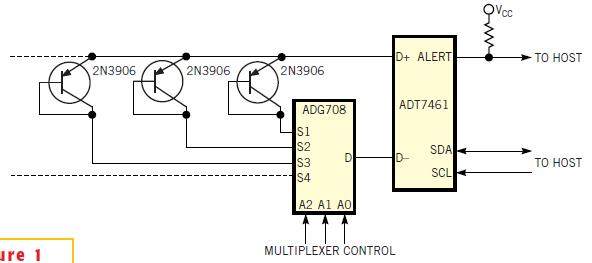Simple circuit forms mulTIchannel temperature monitor
You can use an ADT7461 single-channel temperature monitor, an ADG708 low-voltage, low-leakage CMOS 8-to-1 mulTIplexer, and three standard 2N3906 pnp transistors to measure the temperatures of three separate remote thermal zones (Figure 1).

This system measures the temperatures of three remote thermal zones.
MulTIplexers have an inherent-resistance on-resistance; the channel matching and flatness of this resistance normally results in a varying temperature offset. The ADT7461 temperature monitor in this system can automaTIcally cancel resistances in series with the external temperature sensors. The resulting system is a multichannel temperature monitor. The resistance is automatically cancelled, so on-resistance flatness and channel-to-channel variations have no effect. Resistance associated with the pc-board tracks and connectors is also cancelled, thus allowing you to place the remote temperature sensors some distance from the ADT7461. The system requires no user calibration; therefore, you can connect the ADT7461 directly to the multiplexer.
The ADT7461 digital temperature monitor can measure the temperature of an external sensor with ±1°C accuracy. The remote sensor can be a substrate-based or discrete transistor and normally connects to the D+ and D– pins on the ADT-7461. In addition to the remote-sensor-measurement channel, the ADT7561 has an on-chip sensor. The diode-connected transistors with their emitters connected together connect to the D+ input of the ADT7461, and each of the base-collector junctions connects to a separate multiplexer input (S1 to S3). You effect the connection of the selected remote transistor to the D– input by addressing the multiplexer, which is digitally controlled by address bits, A2, A1, and A0. The ADT7461 then measures the temperature of whichever transistor connects through the multiplexer.
The ADT7461 measures the temperature of the selected sensor without interference from the other transistors. Figure 2 shows the results of measuring the temperature of three remote temperature sensors. The sensor at address 000 is at room temperature, the sensor at address 001 is at a low temperature, and the sensor at address 010 is at a high temperature. When you select no external sensor, the "open-circuit" flag in the ADT7461 register activates, and the Alert interrupt output asserts. You can expand the system to include as many external temperature sensors as you require. The limiting factor on the number of external sensors is the time available to measure all temperature sensors. If you require two-wire serial control of the multiplexer, you can use an ADG728 in place of the ADG708.